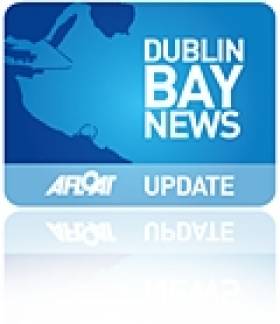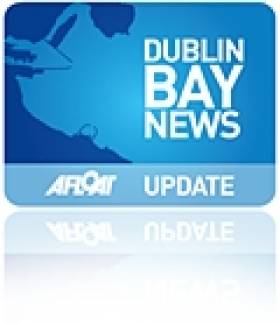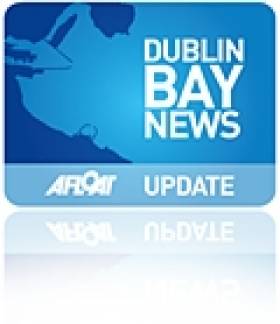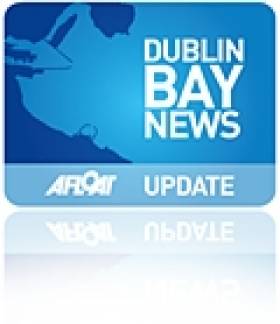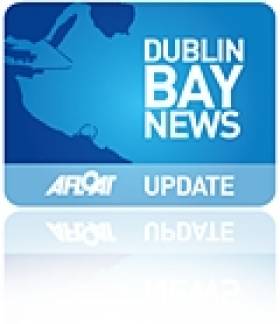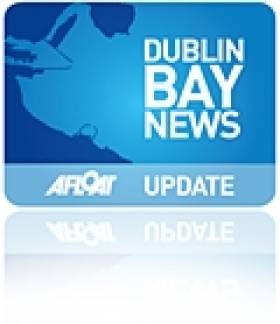Displaying items by tag: Dublin Bay News
#SummerOfHeritage – The annual Summer of Heritage organised by Dun Laoghaire-Rathdown County Council continues its events programme until 7th September.
So there's still time to visit places of interest, among them those with direct links to matters maritime.
Click the following links below to previous postings to reveal further information to the following venues where all have FREE guided tours / walking tours on offer.
Seapoint Martello Tower, Dublin Bay
Seafront Memorials Tours, Dun Laoghaire Harbour
Martello Tower (No.7) & Fortification, Killiney
Noting all tours do not require pre-booking, yet it is advisable to turn up early!... as spaces are limited.
For further details of guided tours, download programme HERE and for locations, dates and times visit: www.dlrevents.ie or call (01) 204 7011
Heritage Week: 'The War to End All Wars' Lecture Series
#HeritageWeekLectures – The Maritime Institute of Ireland is to run a lecture series during Heritage Week under the title of 'The War to End All Wars' held on 31 August in the Eblana Club, Dun Laoghaire.
The lectures are between 12 am and 8 pm and the venue is located on Elana Avenue off Marine Road. Lectures will be accompanied by discussions, debates, music and song.
Registration begins at 11.30, so make sure you book early as places are limited.
Programme details of the eight lectures (can be downloaded in PDF format) from the MII's website: www.mariner.ie
In addition to further details about their National Maritime Museum of Ireland which is located nearby to the Eblana Club.
#KillineyMartello- The annual Summer of Heritage events programme organised by Dun Laoghaire-Rathdown County Council (DLRCoCo) continues throughout the season, writes Jehan Ashmore.
The programme which runs until Sunday 7 September, includes some new and exciting venues for this season for you to see, visit and learn from a series of guided walking tours and all for free!
Among the new heritage site events is the restored Killiney Martello Tower (No.7) and Fortification on Tara Hill in Killiney, which is sited within a walled compound on Killiney Hill Road.
Its elevated position meant that it acted both as a supporting position and as an observation post with commanding coastal views sweeping across Killiney Bay between Dalkey Island and Bray Head.
Manned by 16 men, the tower consisted of an 18-pounder gun, a guardhouse and a raised earthen battery armed with three 24-pounder guns and the structure built between 1804-5, was to repel a threatened French invasion.
In this year's prestigious Europa Nostra Awards, Martello Tower No.7 received 'Special Mention' of the Jury of the European Union Prize for Cultural Heritage.
The Martello Tower was short-listed in the category of Conservation where entries made an outstanding contribution to the conservation and enhancement of heritage and were recognised and particularly appreciated by the Juries.
The Europa Nostra awards receive entries from the entire European continent stretching from Iceland to the Russian Urals and from Norway to Turkey.
Details of Guided Tours
Location: Martello Tower No.7 (Tara Hill) on Killiney Hill Road. Meet just inside the main gates.
Guided Tours (Days): Every Tuesday and Thursday
Tour Times: Hours from 2pm – 5pm (4 tours daily)
Tour Duration: 60 minutes
Max Capacity: 15 people
Notes: Not wheelchair accessible.
Access to roof is very restricted.
Children Must be accompanied by an adult.
Proper footwear is essential.
ALL tours in the Summer of Heritage programme are non-pre booking and places are limited so turn up early!
For further details of guided tours, download programme HERE for details of locations, dates and times. Or visit: www.dlrevents.ie Contact: (01) 204 7011
#dlharbour – The Minister for Transport, Tourism and Sport, Leo Varadkar TD, has announced the appointment of Don McManus to the Board of Dun Laoghaire Harbour Company.
Don McManus – who is Chairperson of Dun Laoghaire Business Improvement District (BID) – has previously served terms on the board of the Harbour Company. Don is from Dun Laoghaire, and is Managing Director of his family-owned business which has operated in Dun Laoghaire since 1928.
The Board of Dún Laoghaire Harbour Company now comprises eight members, which is the maximum membership it can have.
Speaking on the appointments, Chairperson of Dún Laoghaire Harbour Company, Eithne Scott Lennon said: "Don's experience and commitment to improving the Dun Laoghaire is very important, and will be very valuable to the Harbour Company as we continue to expedite the elements of our development plan."
The development plan include the delivery of an International Diaspora Centre, a deep cruise berth facility and a new mixed use housing and retail development. A number of initiatives to add to the leisure offerings at the Harbour have already been instigated, including the Urban Beach project, the Shackleton Exhibition and the new drive-in movie initiative which will commence later this month. A key area of development for the Harbour Company has been the increase in cruise-calls to Dún Laoghaire in recent years, and we expect to deliver 100,000 leisure visitors and crew to Dún Laoghaire and its hinterland in 2015.
#SummerOfHeritage - As previously reported the annual Summer of Heritage events programme organised by Dun Laoghaire-Rathdown County Council (DLRCoCo) started last week.
Running over five days a week until 7 September, the programme this year has some added new and exciting venues for you to see, visit and learn from and for free!
All tours are non-pre booking and places are limited so turn up early!
The events which drew thousands of people last year and to look forward to in 2014 are the various heritage sites across the county and among them are the guided Seafront Memorial Tours held in Dun Laoghaire Harbour.
DETAILS: The first date of these guided walking tours (again no pre-booking) starts tomorrow Sunday, 6 July.
Location: at the Queen Victoria Fountain, Dún Laoghaire.
Descripstion: The tour covers coastal memorials along the harbour waterfront, including the Queen Victoria Fountain, George IV Memorial, the mailboat Leinster's anchor, Christ the King, the Crimean War Cannon and the 1895 Lifeboat Disaster.
Tours: (every Sunday) from 6 July until 7 September
Time: 11.30am (1 tour per day)
Tour: 60 minutes
Max capacity: 20 people
Wheelchair accessible.
This is an outdoor event.
For further details of the full programme download programme HERE for details of locations, dates and times. Or visit: www.dlrevents.ie Contact: (01) 204 7011
#MotorYacht – A US training ship T.S. Empire State made a 'sail-past' in Dublin Bay this morning, however Dublin Port welcomed Katrion, an impressive three-decked 38m motoryacht, writes Jehan Ashmore.
Featuring a Jacuzzi high up on the uppermost deck above the bridge, the Cayman Islands flagged motoryacht is currently advertised for sale through www.y.co for €12,900,000.
She had docked at the 100-berth Poolbeg Yacht Boat Club & Marina having sailed overnight from Waterford. Beforehand she had cruised along the south and south-west coast in recent weeks.
The Georgetown registered vessel built in 2003 is from the Dutch yard of Feadship - which has completed more than 250 such luxurious vessels for wealthy clients globally.
Her interiors are by the hand of Michael Mcquiston / Art-Line Interiors and her last refit is understood to have been in 2008.
Guests have the use of four staterooms, a main salon, living and dining room spaces. Outdoor dining is available on the spacious deck and aft-decks.
Further luxurious facilities are to be found in accommodation for 8-guests, with a master bedroom and master-bathroom, a VIP-guestroom, guest-double and a guest twin. A crew of 7 cater for the needs of discerning clientele.
It is also undestood that her main engines of 2 X 620 HP generate a cruising speed of 11 knots though is capable of 14 knots.
Should dry-land be yearned for after travelling across Ocean's, in which she has a range of 3,000 nautical miles, there are custom-bikes already on board and an awaiting high-speed tender to whisk you ashore.
#UStrainingShips –Afloat.ie can now confirm following our previous report, that the US training ship T.S. Empire State (1962/14,557grt) had made a 'sail-past' only visit of Dublin Bay this morning while en route to Copenhagen.
The vessel is no stranger to Dublin Port having called on previous occasions.
The brief appearance of the former general cargoship on US Independence Day, involved the vessel circling around the southern end of the bay before departing off the Baily Lighthouse.
On board are male and female students from the Maritime College of the State University College of New York (SUNY) who are undertaking their Summer Sea Term, which is held annually.
#UStrainingShips -Today been the 4th July, the United States celebrates its Independence Day where patriotic events take place also overseas and on board a pair of training vessels in Irish waters, writes Jehan Ashmore.
As previously reported on Afloat.ie, the two US training ships visited Cork recently, SSV Corwith Cromar and TS Empire State (1962/14,557grt) though the latter vessel this morning arrived into Dublin Bay.
As part of her annual Summer Sea Term, she is scheduled to visit several European ports and among them the next port is call is understood to the Danish capital of Copenhagen.
The arrival into Dublin Bay of the cadetship with students from the Maritime College of the State University College of New York (SUNY) is somewhat surprising, though for the last three days she undertook training exercises held off Cork Harbour with overnight anchorage taken offshore.
It remains to be confirmed if the former general cargoship which has visited Dublin Port previously is set to make an un-scheduled call.
Or this could merely be a 'sail-past' of Dublin as part of the route taken of the Empire State during her passage through the Irish Sea, past Scotland and onward to Scandinavia.
Also following a transatlantic sail from the US East coast, the other training vessel, the steel-hulled 1988 built SSV Corwith Cramer which made her first visit to Cork. She remains berthed at Cork City Marina where she was open to the public last Sunday.
On Tuesday a talk "One Ocean: Lightening Talks on Ocean Discovery" was held on board with researchers from the US and Ireland. She is due to depart on Sunday.
#SummerOfHeritage- The annual Summer of Heritage events programme organised by Dun Laoghaire-Rathdown County Council (DLRCoCo) started today.
Running over five days a week for the next ten weeks until 7 September the programme has some added new and exciting venues this year for you to see, visit and learn from. All for free! for adults and children alike.
Among the events which drew thousands of people in 2013 when visiting various heritage sites across the county was and will continue to be the Martello Tower at Seapoint where guided tours are held. A unique story told in a unique setting.
The tower is one of a series along with batteries built between Bray and Balbriggan in 1804-5 to repel a threatened French invasion.
The first tour starts tomorrow, 2 July (and every Wednesday plus all Sundays). Hourly tours of 4 held on both selected days (2pm-5pm) and are restricted to 15 persons. They are not wheelchair accessible.
This is both an indoor and outdoor event where proper footwear is essential, noting bare feet are not allowed. Access to roof is very restricted. Noting, children 'must' be accompanied by an adult.
For further details of the full programme of guided tours, download the Summer of Heritage brochure HERE and which also outlines locations, dates and times.
Or visit: www.dlrevents.ie or by contacting: (01) 204 7011
Damp Puts Damper On Joyce Tower Museum Plans
#DublinBay - James Joyce scholars have received some unwelcome news with a new report finding that the Joyce Tower in Sandycove unsuitable for storing a first edition of the author's most famed work Ulysses, among other delicate materials.
According to the Irish Independent, the report commissioned by Dun Laoghaire Rathdown County Council has identified that the seaside Martello tower in Sandycove - which featured prominently in Ulysses, and is due to reopen shortly following months of renovations - is unsuitable for housing rare papers due to damp conditions.
The news comes as a blow to Joyceans and the county council alike, the latter after investing more than €200,000 in the building to convert it and its present museum into what's expected to be a major tourist attraction.
The Irish Independent has more on the story HERE.
Update 10/4: Dun Laoghaire Rathdown County Council has since posted an update on the Joyce Tower renovations, claiming that recent news reports were based on incomplete information.
"The reported problem with damp in the tower was identified as an issue by the council in its first discussions with Fáilte Ireland and was also noted in the consultants report," the statements reads.
"Since the museum consultant's visit to the tower last year, Fáilte Ireland has been carrying out work on the conservation of the tower which we believe has addressed many of the structural issues, some of which related to the ingress of water and damp.
"The museum consultant who produced the report had not revisited the Tower following the works and therefore had not taken them into account in his report."


























